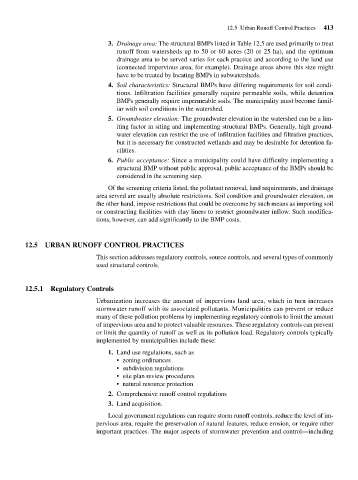Page 455 - Fair, Geyer, and Okun's Water and wastewater engineering : water supply and wastewater removal
P. 455
JWCL344_ch12_398-456.qxd 8/4/10 9:37 PM Page 413
12.5 Urban Runoff Control Practices 413
3. Drainage area: The structural BMPs listed in Table 12.5 are used primarily to treat
runoff from watersheds up to 50 or 60 acres (20 or 25 ha), and the optimum
drainage area to be served varies for each practice and according to the land use
(connected impervious area, for example). Drainage areas above this size might
have to be treated by locating BMPs in subwatersheds.
4. Soil characteristics: Structural BMPs have differing requirements for soil condi-
tions. Infiltration facilities generally require permeable soils, while detention
BMPs generally require impermeable soils. The municipality must become famil-
iar with soil conditions in the watershed.
5. Groundwater elevation: The groundwater elevation in the watershed can be a lim-
iting factor in siting and implementing structural BMPs. Generally, high ground-
water elevation can restrict the use of infiltration facilities and filtration practices,
but it is necessary for constructed wetlands and may be desirable for detention fa-
cilities.
6. Public acceptance: Since a municipality could have difficulty implementing a
structural BMP without public approval, public acceptance of the BMPs should be
considered in the screening step.
Of the screening criteria listed, the pollutant removal, land requirements, and drainage
area served are usually absolute restrictions. Soil condition and groundwater elevation, on
the other hand, impose restrictions that could be overcome by such means as importing soil
or constructing facilities with clay liners to restrict groundwater inflow. Such modifica-
tions, however, can add significantly to the BMP costs.
12.5 URBAN RUNOFF CONTROL PRACTICES
This section addresses regulatory controls, source controls, and several types of commonly
used structural controls.
12.5.1 Regulatory Controls
Urbanization increases the amount of impervious land area, which in turn increases
stormwater runoff with its associated pollutants. Municipalities can prevent or reduce
many of these pollution problems by implementing regulatory controls to limit the amount
of impervious area and to protect valuable resources. These regulatory controls can prevent
or limit the quantity of runoff as well as its pollution load. Regulatory controls typically
implemented by municipalities include these:
1. Land use regulations, such as
• zoning ordinances
• subdivision regulations
• site plan review procedures
• natural resource protection
2. Comprehensive runoff control regulations
3. Land acquisition.
Local government regulations can require storm runoff controls, reduce the level of im-
pervious area, require the preservation of natural features, reduce erosion, or require other
important practices. The major aspects of stormwater prevention and control—including

